Marina De Vos
University of Bath
Understanding the Process of Human-AI Value Alignment
Sep 17, 2025Abstract:Background: Value alignment in computer science research is often used to refer to the process of aligning artificial intelligence with humans, but the way the phrase is used often lacks precision. Objectives: In this paper, we conduct a systematic literature review to advance the understanding of value alignment in artificial intelligence by characterising the topic in the context of its research literature. We use this to suggest a more precise definition of the term. Methods: We analyse 172 value alignment research articles that have been published in recent years and synthesise their content using thematic analyses. Results: Our analysis leads to six themes: value alignment drivers & approaches; challenges in value alignment; values in value alignment; cognitive processes in humans and AI; human-agent teaming; and designing and developing value-aligned systems. Conclusions: By analysing these themes in the context of the literature we define value alignment as an ongoing process between humans and autonomous agents that aims to express and implement abstract values in diverse contexts, while managing the cognitive limits of both humans and AI agents and also balancing the conflicting ethical and political demands generated by the values in different groups. Our analysis gives rise to a set of research challenges and opportunities in the field of value alignment for future work.
A Norm Emergence Framework for Normative MAS -- Position Paper
Apr 06, 2020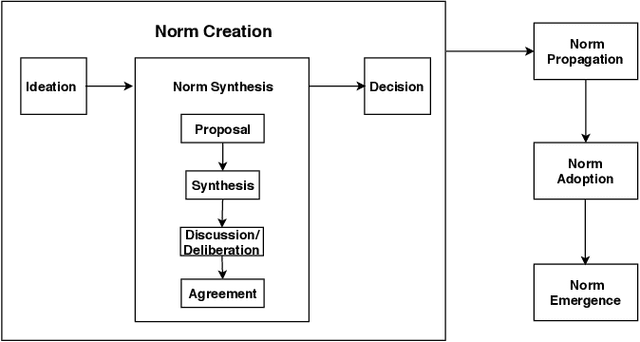
Abstract:Norm emergence is typically studied in the context of multiagent systems (MAS) where norms are implicit, and participating agents use simplistic decision-making mechanisms. These implicit norms are usually unconsciously shared and adopted through agent interaction. A norm is deemed to have emerged when a threshold or predetermined percentage of agents follow the "norm". Conversely, in normative MAS, norms are typically explicit and agents deliberately share norms through communication or are informed about norms by an authority, following which an agent decides whether to adopt the norm or not. The decision to adopt a norm by the agent can happen immediately after recognition or when an applicable situation arises. In this paper, we make the case that, similarly, a norm has emerged in a normative MAS when a percentage of agents adopt the norm. Furthermore, we posit that agents themselves can and should be involved in norm synthesis, and hence influence the norms governing the MAS, in line with Ostrom's eight principles. Consequently, we put forward a framework for the emergence of norms within a normative MAS, that allows participating agents to propose/request changes to the normative system, while special-purpose synthesizer agents formulate new norms or revisions in response to these requests. Synthesizers must collectively agree that the new norm or norm revision should proceed, and then finally be approved by an "Oracle". The normative system is then modified to incorporate the norm.
Proceedings 35th International Conference on Logic Programming (Technical Communications)
Sep 17, 2019Abstract:Since the first conference held in Marseille in 1982, ICLP has been the premier international event for presenting research in logic programming. Contributions are sought in all areas of logic programming, including but not restricted to: Foundations: Semantics, Formalisms, Nonmonotonic reasoning, Knowledge representation. Languages: Concurrency, Objects, Coordination, Mobility, Higher Order, Types, Modes, Assertions, Modules, Meta-programming, Logic-based domain-specific languages, Programming Techniques. Declarative programming: Declarative program development, Analysis, Type and mode inference, Partial evaluation, Abstract interpretation, Transformation, Validation, Verification, Debugging, Profiling, Testing, Execution visualization Implementation: Virtual machines, Compilation, Memory management, Parallel/distributed execution, Constraint handling rules, Tabling, Foreign interfaces, User interfaces. Related Paradigms and Synergies: Inductive and Co-inductive Logic Programming, Constraint Logic Programming, Answer Set Programming, Interaction with SAT, SMT and CSP solvers, Logic programming techniques for type inference and theorem proving, Argumentation, Probabilistic Logic Programming, Relations to object-oriented and Functional programming. Applications: Databases, Big Data, Data integration and federation, Software engineering, Natural language processing, Web and Semantic Web, Agents, Artificial intelligence, Computational life sciences, Education, Cybersecurity, and Robotics.
Practical Reasoning with Norms for Autonomous Software Agents (Full Edition)
Jan 28, 2017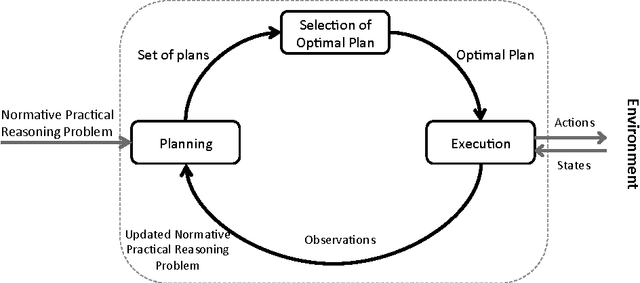
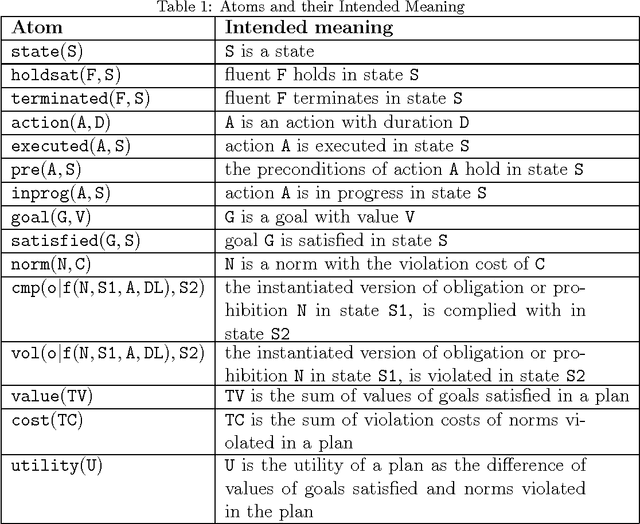
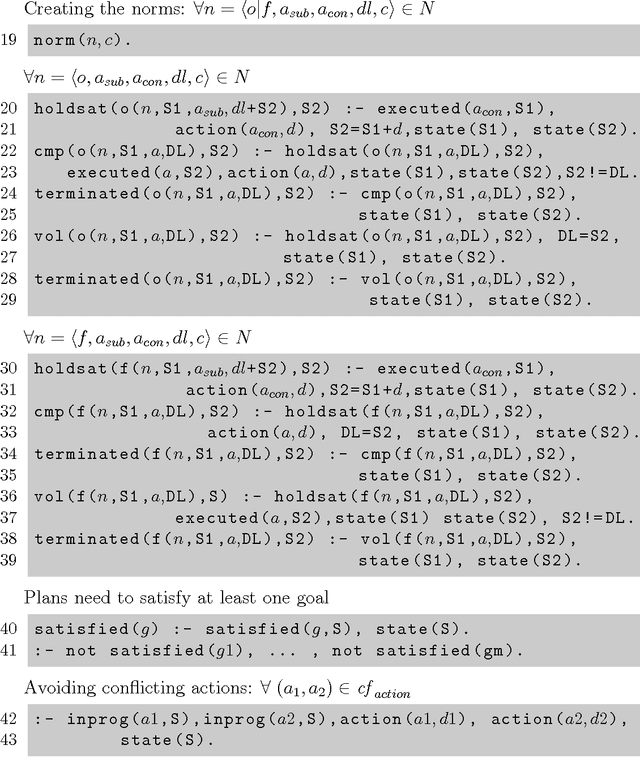

Abstract:Autonomous software agents operating in dynamic environments need to constantly reason about actions in pursuit of their goals, while taking into consideration norms which might be imposed on those actions. Normative practical reasoning supports agents making decisions about what is best for them to (not) do in a given situation. What makes practical reasoning challenging is the interplay between goals that agents are pursuing and the norms that the agents are trying to uphold. We offer a formalisation to allow agents to plan for multiple goals and norms in the presence of durative actions that can be executed concurrently. We compare plans based on decision-theoretic notions (i.e. utility) such that the utility gain of goals and utility loss of norm violations are the basis for this comparison. The set of optimal plans consists of plans that maximise the overall utility, each of which can be chosen by the agent to execute. We provide an implementation of our proposal in Answer Set Programming, thus allowing us to state the original problem in terms of a logic program that can be queried for solutions with specific properties. The implementation is proven to be sound and complete.
Artificial Prediction Markets for Online Prediction of Continuous Variables-A Preliminary Report
Aug 11, 2015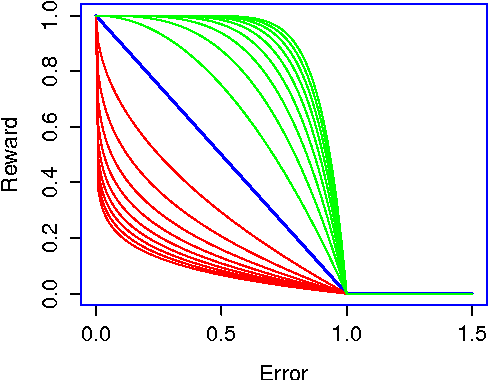

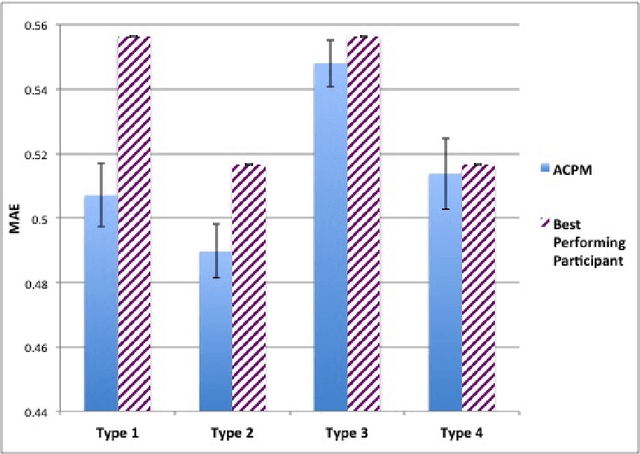
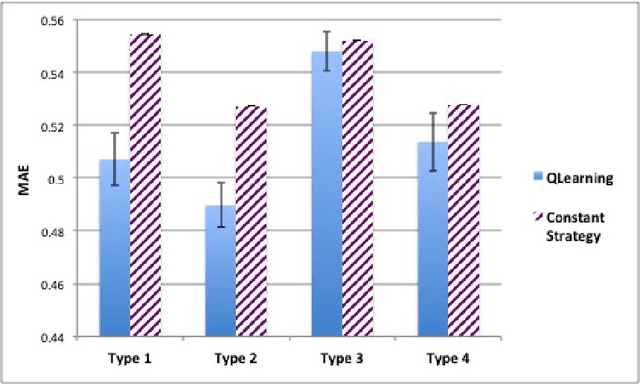
Abstract:We propose the Artificial Continuous Prediction Market (ACPM) as a means to predict a continuous real value, by integrating a range of data sources and aggregating the results of different machine learning (ML) algorithms. ACPM adapts the concept of the (physical) prediction market to address the prediction of real values instead of discrete events. Each ACPM participant has a data source, a ML algorithm and a local decision-making procedure that determines what to bid on what value. The contributions of ACPM are: (i) adaptation to changes in data quality by the use of learning in: (a) the market, which weights each market participant to adjust the influence of each on the market prediction and (b) the participants, which use a Q-learning based trading strategy to incorporate the market prediction into their subsequent predictions, (ii) resilience to a changing population of low- and high-performing participants. We demonstrate the effectiveness of ACPM by application to an influenza-like illnesses data set, showing ACPM out-performs a range of well-known regression models and is resilient to variation in data source quality.
Annotating Answer-Set Programs in LANA?
Oct 08, 2012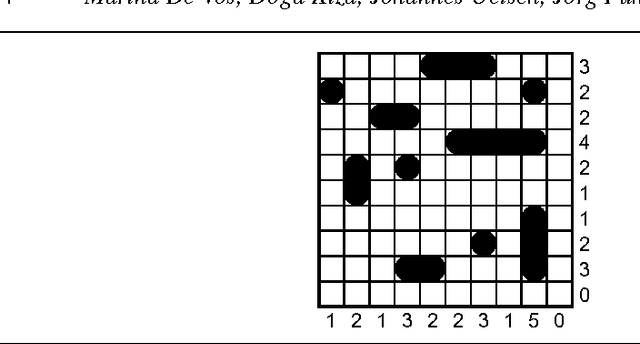
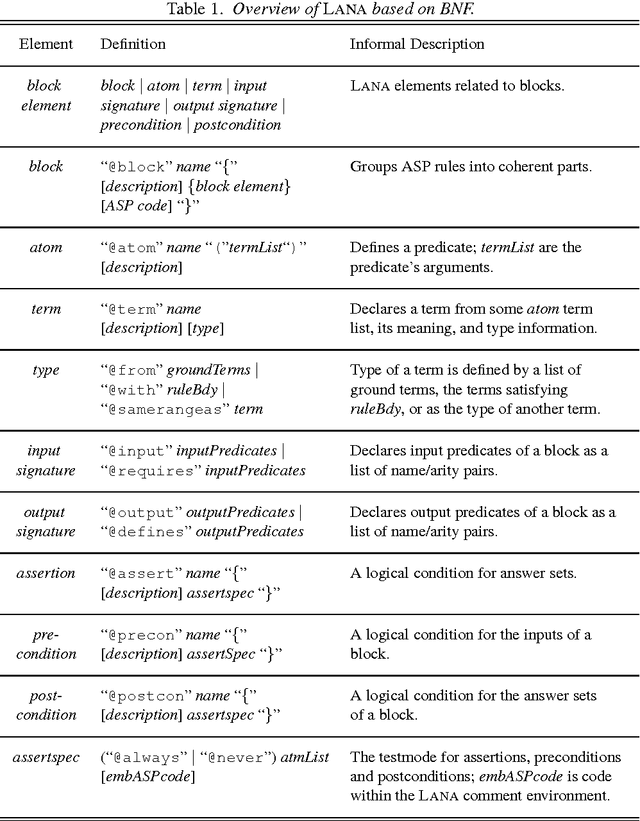
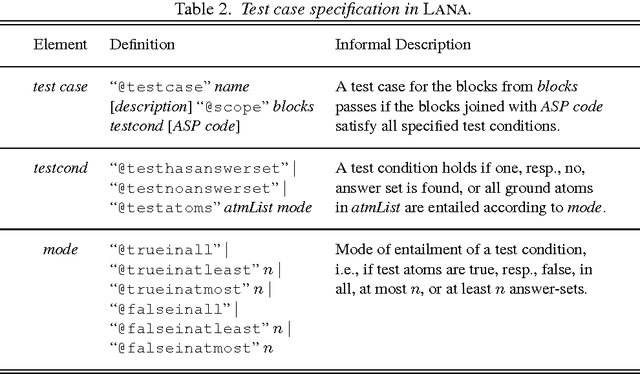
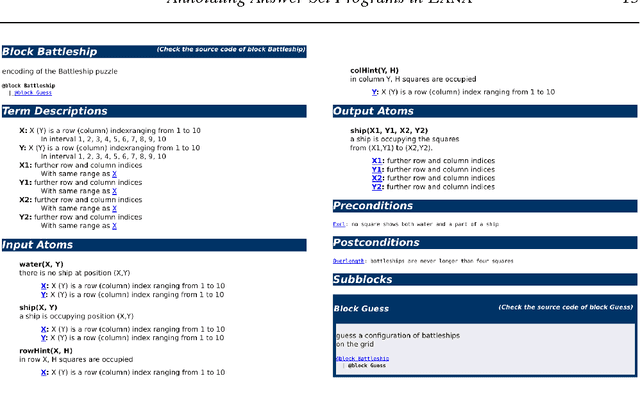
Abstract:While past research in answer-set programming (ASP) mainly focused on theory, ASP solver technology, and applications, the present work situates itself in the context of a quite recent research trend: development support for ASP. In particular, we propose to augment answer-set programs with additional meta-information formulated in a dedicated annotation language, called LANA. This language allows the grouping of rules into coherent blocks and to specify language signatures, types, pre- and postconditions, as well as unit tests for such blocks. While these annotations are invisible to an ASP solver, as they take the form of program comments, they can be interpreted by tools for documentation, testing, and verification purposes, as well as to eliminate sources of common programming errors by realising syntax checking or code completion features. To demonstrate its versatility, we introduce two such tools, viz. (i) ASPDOC, for generating an HTML documentation for a program based on the annotated information, and (ii) ASPUNIT, for running and monitoring unit tests on program blocks. LANA is also exploited in the SeaLion system, an integrated development environment for ASP based on Eclipse. To appear in Theory and Practice of Logic Programming
Normative design using inductive learning
Jul 25, 2011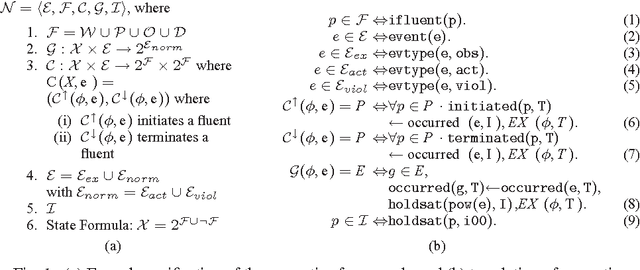

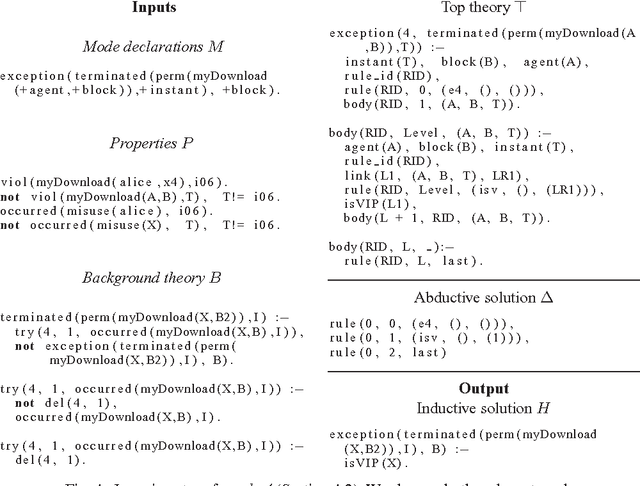
Abstract:In this paper we propose a use-case-driven iterative design methodology for normative frameworks, also called virtual institutions, which are used to govern open systems. Our computational model represents the normative framework as a logic program under answer set semantics (ASP). By means of an inductive logic programming approach, implemented using ASP, it is possible to synthesise new rules and revise the existing ones. The learning mechanism is guided by the designer who describes the desired properties of the framework through use cases, comprising (i) event traces that capture possible scenarios, and (ii) a state that describes the desired outcome. The learning process then proposes additional rules, or changes to current rules, to satisfy the constraints expressed in the use cases. Thus, the contribution of this paper is a process for the elaboration and revision of a normative framework by means of a semi-automatic and iterative process driven from specifications of (un)desirable behaviour. The process integrates a novel and general methodology for theory revision based on ASP.
Automatic Music Composition using Answer Set Programming
Jun 25, 2010



Abstract:Music composition used to be a pen and paper activity. These these days music is often composed with the aid of computer software, even to the point where the computer compose parts of the score autonomously. The composition of most styles of music is governed by rules. We show that by approaching the automation, analysis and verification of composition as a knowledge representation task and formalising these rules in a suitable logical language, powerful and expressive intelligent composition tools can be easily built. This application paper describes the use of answer set programming to construct an automated system, named ANTON, that can compose melodic, harmonic and rhythmic music, diagnose errors in human compositions and serve as a computer-aided composition tool. The combination of harmonic, rhythmic and melodic composition in a single framework makes ANTON unique in the growing area of algorithmic composition. With near real-time composition, ANTON reaches the point where it can not only be used as a component in an interactive composition tool but also has the potential for live performances and concerts or automatically generated background music in a variety of applications. With the use of a fully declarative language and an "off-the-shelf" reasoning engine, ANTON provides the human composer a tool which is significantly simpler, more compact and more versatile than other existing systems. This paper has been accepted for publication in Theory and Practice of Logic Programming (TPLP).
 Add to Chrome
Add to Chrome Add to Firefox
Add to Firefox Add to Edge
Add to Edge